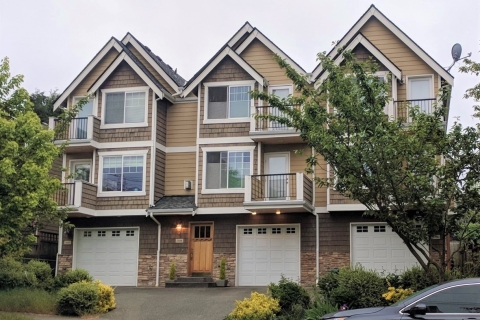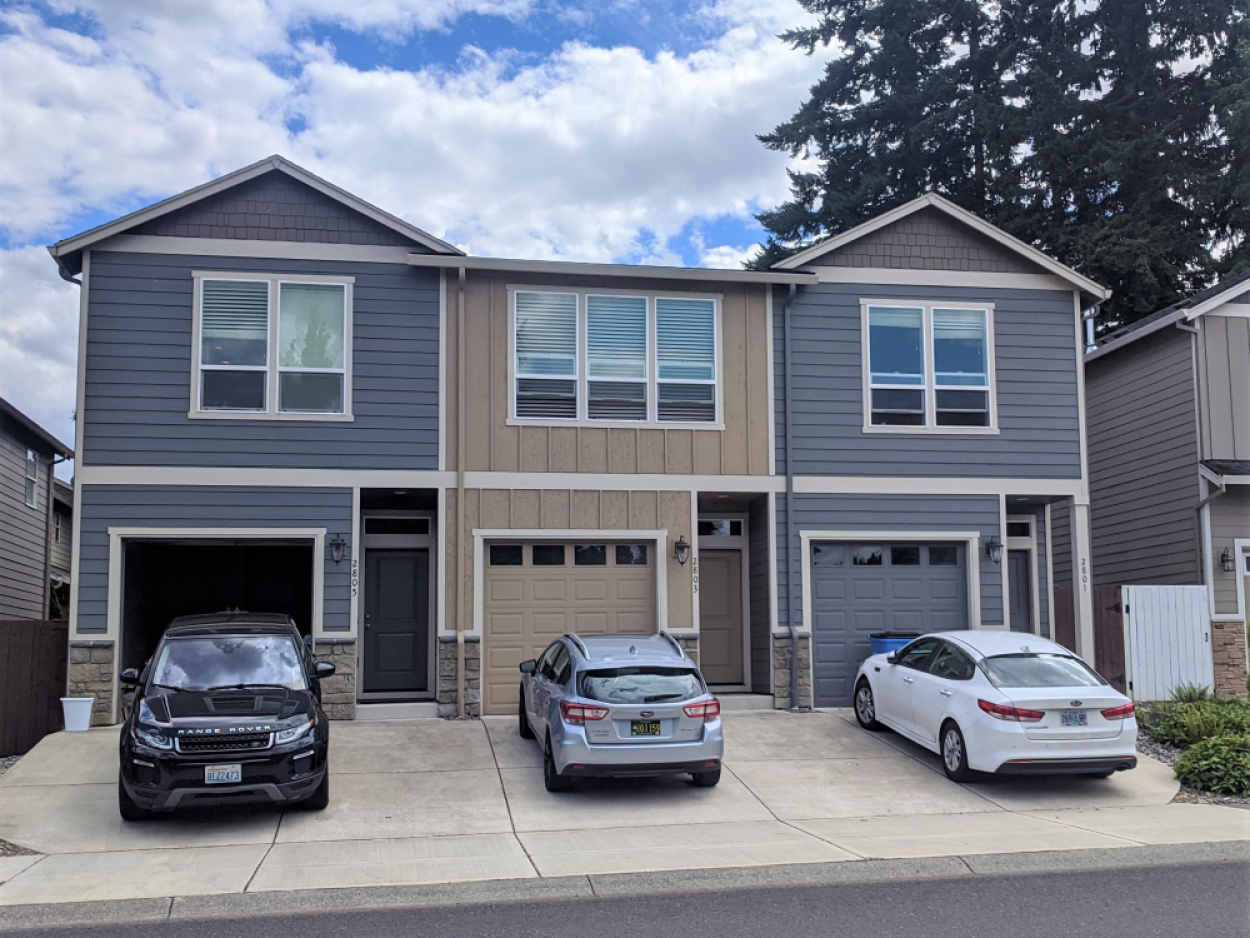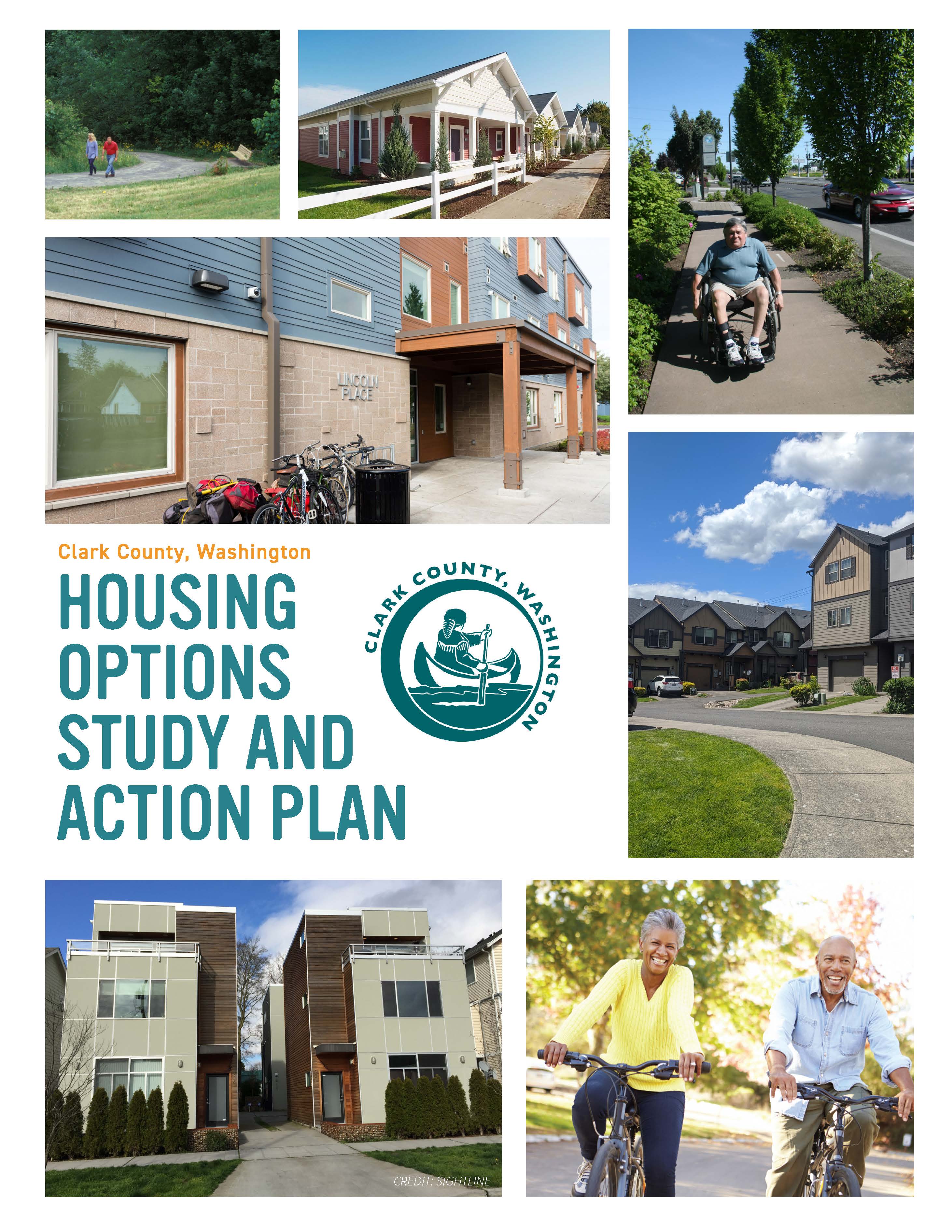Middle Housing Code Changes

Photo of an attached urban Accessory Dwelling Unit (ADU)
This page outlines helpful information and answers to frequently asked questions about new housing code changes adopted in early 2024. To find more general information about the Housing Options Study and Action Plan (HOSAP) and other housing initiatives in the county, visit this page.
Frequently Asked Questions (FAQs)
The first set of code changes adopted to implement the Clark County Housing Options Study and Action Plan (HOSAP) focus on the shorter-term middle housing and small single-family strategies of the plan. On March 5, 2024, the Clark County Council unanimously approved the proposed housing code modifications. Ordinance 2024-03-02 and Ordinance 2024-06-04 codify the code changes.
Middle housing, sometimes termed “missing middle” housing, is a term used to refer to housing in the middle of a spectrum between single-family detached homes and apartment buildings. Middle housing types include accessory dwelling units (ADUs), duplexes, triplexes, quadplexes, townhouses, cottage clusters and others that can be built at a neighborhood scale.
Interest in reviving middle housing is seen across the country. Cities across Washington including Olympia, Spokane and Tacoma are expanding middle housing options, and closer to home Vancouver and Ridgefield have made changes in the past several years to allow more housing variety. The state legislature has considered several measures to support greater housing variety and affordability in previous and current sessions, including middle housing options. Our neighbors in Oregon have taken statewide action to ensure some types of middle housing are permitted in all cities with more than 10,000 people.
Like other communities in the region, the unincorporated area of the Vancouver Urban Growth Area (VUGA) is facing increasing housing prices alongside new population growth. Affordable rental and homeownership options are increasingly out of reach for current residents and those seeking a new life in the community.
Like other communities in the region, the unincorporated area of the Vancouver Urban Growth Area (VUGA) is facing increasing housing prices alongside new population growth. Affordable rental and homeownership options are increasingly out of reach for current residents and those seeking a new life in the community. In response to these concerns, the Clark County Council adopted the Housing Options Study and Action Plan with direction to staff to immediately begin implementation of an initial round of zoning code updates. Phase 1 of the code changes focused on these six concepts:
- Use existing land more efficiently. Allow more housing to be built on land already planned for residential development on modestly smaller lots than currently required. Reduce existing minimum lot sizes by 10-20% with corresponding adjustments to minimum lot dimensions, resulting in relatively more homes that can be built.
- Allow more variety of smaller scale housing throughout neighborhoods. Permit accessory dwelling units (ADUs), duplexes, triplexes, quadplexes, townhouses and smaller single-family detached homes throughout low density zones. These housing types are collectively termed ‘middle housing’ and typically provide smaller, more compact home options sought out by smaller households and are less expensive than larger homes.
- Maintain neighborhood scale for new development. Set comparable sizes for new middle housing options and single-family detached homes, including similar minimum lot sizes, heights and setbacks. Some middle housing and smaller single-family detached options also require a balance of elements along the frontage to include main entrances as well as room for garages and driveways.
- Expand options for more, smaller homes in new developments. Refine the existing cottage housing development option to focus site development on clusters of smaller, one to two-story homes around a common open space. Introduce a compact lot development option for more traditional street-oriented homes on smaller lots down to half the size of lots in the existing zone to increase the number of new homes that can be accommodated in new developments.
- Make room for more housing with modest off-street parking reductions. Shift some off-street parking for townhouses into a guest parking requirement, reduce cottage parking minimums to one space per cottage, and require a minimum of one parking space per duplex, triplex and quadplex unit. Together these standards create more flexibility to develop middle housing on modestly sized lots, while still allowing flexibility for developers that choose to provide more parking.
- Permit more housing through streamlined permitting processes. Apply clear standards developed through this process to more housing proposals, and reduce reviews currently required for townhouses, triplexes and quadplexes in these areas.
While the new provisions will not directly govern the prices of any new homes—just as housing prices are not currently regulated by the county—the intent of the code changes is to permit a greater variety of smaller homes on smaller lots with lower land and construction costs on average. Middle housing can expand housing options that are affordable to a certain segment of middle-income households that are priced out of larger single-family homes. Generally speaking, it is not a low-cost housing type affordable to lower-income households, which will be addressed in the Phase 2 code changes, which is outlined further below in the FAQ titled, “What code changes are planned in the future?”
“Affordable housing” is often used broadly in planning to mean housing that does not cost more 30% of the household income, at every income level. More specifically, “affordable housing” can mean housing affordable to low-income households, say those earning up to 60 or 80% of the area median income (AMI). In that sense, middle housing can often be “affordable” to households earning 100-120% of AMI where middle housing costs are not more than 30% of those households’ incomes, or approximately $2,250-2,700 per month.2 Some middle housing may be affordable to more households on the margins depending on certain code and design provisions. Small single-family and middle housing types supported by the proposed code changes will likely not be “affordable” to low-income workers, especially not new middle housing, because costs would exceed 30% of those households’ incomes.
As highlighted in the state’s recently adopted middle housing legislation, House Bill 1110, middle housing’s key contribution to affordability comes from the inherent efficiencies at smaller scales and higher density, both in their construction and reduced household energy and transportation costs. Development code provisions will then further affect construction costs for an individual property, which would be reflected in the ultimate sale or rental price for middle housing. The total cost for housing, however, is a complex combination of many factors from land prices to infrastructure costs to materials and construction costs that make it difficult to predict the specific monetary impact of a given code requirement.
2 Based on 2022 median Clark County household income of $90,115. https://www.census.gov/quickfacts/fact/table/clarkcountywashington,US/PST045223
Households are changing across the county, reflecting changes at the regional and national levels. We are seeing more one to two-person households such as empty nesters, retirees, young couples, single-parent households, and single adults. Nearly 60% of Clark County households are currently one or two people, and the share of smaller households is expected to rise. However, the majority of the homes available in the county today are single-family detached homes sized and priced for larger households. The code changes aim to expand opportunities to create additional smaller homes that can meet the needs of changing households, to supplement the existing larger homes.
The adopted changes affect the low-density residential zones within the unincorporated Vancouver Urban Growth Area (UGA), including neighborhoods such as Hazel Dell, Salmon Creek, Felida, Pleasant Highlands, Minnehaha and Orchards. The focus is on expanding options within areas developed as and planned for urban levels of development that can be served by public utilities with access to places to work, shop and play such as parks and schools.

photo of attached single family dwelling units

photo of attached single family dwelling units
It will be up to individual property owners to decide whether or not to make any changes to existing homes: most homes will remain unchanged. Modest changes, if any, might look like the addition of an ADU in the backyard, or a single vacant lot developed with a duplex or triplex. Neighborhoods with larger undeveloped properties may see new development, including middle housing options.
Yes, single-family detached homes continue to be allowed in all the areas where they are currently permitted, both existing homes and as an option for new construction. These zoning changes simply add additional housing options that can be but are not required to be built.
The adopted changes to parking requirements affect the minimum number of off-street parking spaces required with a development. However, developers still have the option to incorporate more off-street parking as desired. We’ve already heard some local developers say that they aim to exceed the minimum parking requirements on projects where they believe homebuyers would want extra parking. There will also be options for on-street parking in many neighborhoods on both existing and proposed public streets. While there may be additional cars associated with new development, reducing required minimums for off-street parking is intended to reduce obstacles to development of much needed housing. There will continue to be county review of proposed developments, including coordination with the Fire Marshal, to ensure that emergency access is protected.
We know housing prices are continuing to rise and that more people are moving to the region, so the time is ripe to expand housing options. The Clark County Council unanimously adopted the HOSAP in May 2022 with direction to staff to immediately begin implementation of an initial round of zoning code updates. Zoning updates were prioritized for the initial implementation action because the county has direct control over development regulations and can set the tone for residential development opportunities while also pursuing longer-term strategies that rely on additional funding or partnerships.
There will likely be a mix of opportunities for both sale and rent. Some housing types lend themselves more readily to ownership, like townhouses and cottages, while developments with more than one unit on a lot like a triplex may more commonly become rentals. The zoning regulations will not address ownership of structures for new housing, just as they do not today.
The code changes do incorporate some changes in review requirements and related fees. A lower type of review is now required for triplexes and quadplexes. This is estimated to save an applicant $7,435 and 85 days in review time, in addition to potential savings on “soft costs” for design professionals to prepare the application. The other side of the cost equation is the value of housing which is also likely to change over time as values and priorities change. Additional value is created in livable communities and connected neighborhoods that may not be reflected in the initial costs of construction, making it difficult to say precisely how a given code provision would affect initial costs and long-term value of a given home. Affordability is a central component of any housing strategy and must be supported along with other community priorities around livability and sustainability.
Upcoming code updates to better support multifamily development in the second phase of HOSAP implementation will help the County make even greater strides supporting housing affordability. Recent new state legislation, House Bill 1220, expands the County’s responsibilities to create opportunities for development of wide variety of housing types that is affordable to all income levels/bands, beyond single-family homes which currently make up over 75% of the County’s housing units.
The WA State Department of Commerce has provided guidance for housing needs for each jurisdiction by income band as part of the 20-year comprehensive plan update. The preliminary indications are that two-thirds of the housing need will be in the form of multi-unit complexes (2-6 units) and apartment buildings affordable to lower income households.
And the two phases of code updates are just the beginning, not the end, of the adopted strategies in the HOSAP to support greater housing affordability. The HOSAP objectives include the specific charge to, “Develop strategies to support the development of housing that is affordable to low, very low, and extremely low-income households,” in addition to objectives to develop middle income housing and broader housing options for rent or ownership.
Specific strategies to support affordable housing adopted in the plan go beyond initial code updates to include expanding siting opportunities for regulated affordable housing projects, further support for manufactured home parks, financial support for affordable housing projects, and developing partnerships with local housing agencies and mission-driven developers of affordable housing .

photo of an urban duplex dwelling

photo of attached single family dwelling units
